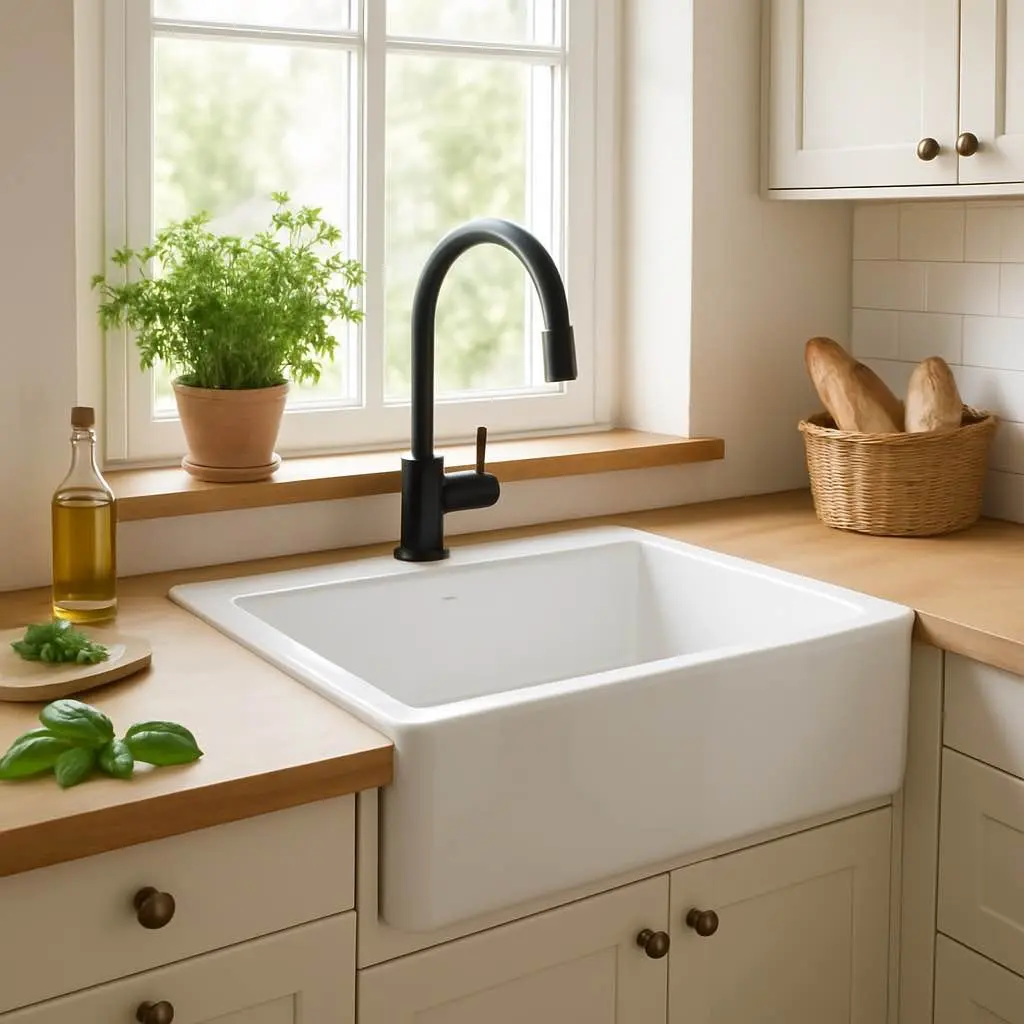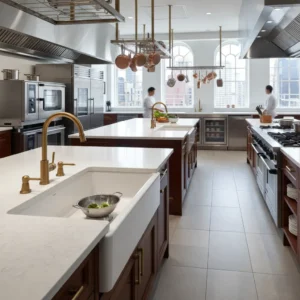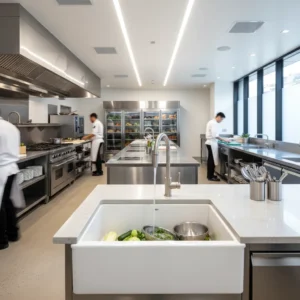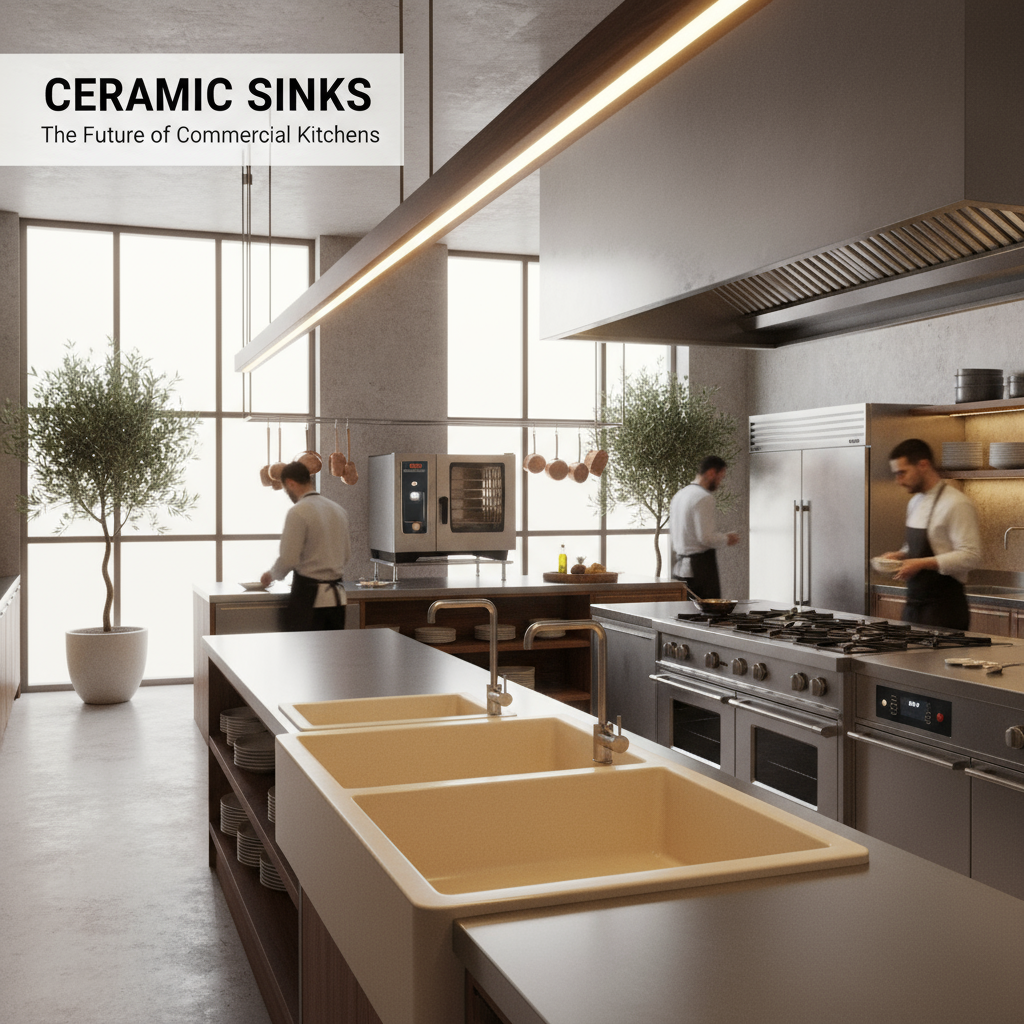Commercial kitchens in hotels and restaurants face a constant battle against wear, stains, and the relentless demands of high-volume operations. Traditional stainless steel sinks, while popular, often show scratches and lose their appeal after months of heavy use, creating maintenance headaches and aesthetic concerns for hospitality managers.
Looking for Stylish and Durable Kitchen Sinks?
Explore our range of porcelain kitchen sinks made from Vitreous China. With a sleek finish, easy cleaning, and antibacterial properties, these sinks combine functionality with elegance for your kitchen.




This is where **ceramic sink applications** are transforming commercial kitchen design. Unlike their stainless steel counterparts, ceramic sinks maintain their pristine appearance even in the most demanding environments, offering superior stain resistance and lasting visual appeal. For architects, builders, and FF&E consultants working on hospitality projects, understanding where ceramic sinks excel can be the difference between a kitchen that looks tired after a year and one that maintains its professional appearance for decades.
This guide explores the specific commercial environments where ceramic sinks deliver maximum value, from bustling restaurant prep areas to luxury hotel service kitchens, helping you make informed decisions for your next hospitality project.
Why Ceramic Sinks Are Transforming Commercial Kitchen Design
The commercial kitchen landscape has undergone a significant transformation in recent years, with ceramic sink applications leading the charge in hospitality design. As hotels and restaurants prioritize both functionality and aesthetics, traditional stainless steel fixtures are giving way to more sophisticated ceramic solutions that can handle the demands of high-volume operations.
Commercial kitchens in upscale hotels and restaurants face unique challenges that standard residential fixtures simply cannot address. The constant exposure to high temperatures, aggressive cleaning chemicals, and heavy daily use requires materials that maintain their appearance while delivering reliable performance. This is where ceramic kitchen sinks have proven their worth, offering a game-changing alternative to conventional options.
“Ceramic sinks in commercial settings show remarkable resistance to staining and chemical damage, making them increasingly popular among hospitality professionals who need both durability and visual appeal.”
The Evolution of Commercial Kitchen Sink Materials
Historically, commercial kitchens relied heavily on stainless steel due to its perceived durability and cost-effectiveness. However, the hospitality industry’s growing emphasis on design aesthetics has created demand for materials that perform well while enhancing the overall kitchen environment. Ceramic materials have emerged as the preferred choice for establishments seeking to balance practical requirements with visual sophistication.
The shift toward ceramic sink applications in commercial settings reflects broader trends in hospitality design. Modern hotels and restaurants understand that kitchen aesthetics impact staff morale and can even influence guest perceptions in open-kitchen concepts. This evolution has prompted facility managers to reconsider their material choices and invest in fixtures that deliver long-term value.
Ceramic vs. Stainless Steel Performance Comparison
| Performance Factor | Ceramic Sinks | Stainless Steel | Industry Benchmark | Maintenance Frequency | Cost Impact |
|---|---|---|---|---|---|
| Stain Resistance | Excellent (95%) | Moderate (70%) | 85% | Weekly deep clean | Low |
| Chemical Damage | Minimal (5%) | Moderate (25%) | 15% | Monthly inspection | Medium |
| Heat Shock Resistance | Superior (98%) | Good (85%) | 90% | Quarterly assessment | Low |
| Aesthetic Retention | Outstanding (92%) | Fair (65%) | 80% | Daily visual check | High |
| Noise Reduction | Excellent (40dB) | Poor (60dB) | 50dB | Not applicable | Productivity gain |
Key Properties for Hospitality Settings
Commercial ceramic sinks offer several advantages that make them particularly suitable for hospitality environments. Their non-porous surface prevents bacterial growth, which is crucial for food safety compliance in restaurant kitchens. Additionally, the smooth finish makes cleaning more efficient, reducing labor costs and ensuring consistent sanitation standards.
The benefits of ceramic sinks in hotels extend beyond basic functionality. These fixtures maintain their appearance even under heavy use, eliminating the need for frequent replacements that can disrupt kitchen operations. The material’s inherent resistance to scratching and chipping ensures that the investment continues to pay dividends over time.
Industry Adoption Trends
Recent data indicates that luxury hotels and high-end restaurants are increasingly specifying ceramic sink applications for their renovation and new construction projects. This trend reflects the industry’s recognition that quality fixtures contribute to operational efficiency and brand reputation. Establishments that have made the switch report improved staff satisfaction and reduced maintenance requirements.
Seletti’s experience in sourcing ceramic fixtures for commercial projects has revealed that hospitality developers prioritize suppliers who can guarantee consistent quality and timely delivery. Our rigorous inspection processes and established logistics networks enable faster project completion, helping clients meet aggressive construction schedules while maintaining quality standards that protect their brand reputation.
Featured image suggestion: Modern commercial kitchen featuring ceramic sinks in a luxury hotel setting, showcasing both functionality and aesthetic appeal.


Hotel Kitchen Applications: Where Ceramic Sinks Excel
Hotel kitchens operate under demanding conditions that require fixtures capable of maintaining both performance and appearance. From luxury service kitchens to high-volume banquet operations, ceramic sink applications have proven their worth in environments where standard materials often fall short. The hospitality industry’s growing recognition of ceramic sinks reflects their unique ability to handle intensive daily use while preserving the aesthetic standards that upscale hotels demand.
Modern hotel kitchen design requires a careful balance between functionality and visual appeal, especially in establishments where open kitchen concepts allow guests to observe food preparation. This visibility makes the choice of fixtures critical, as they must perform flawlessly while contributing to the overall dining experience. Ceramic sinks have emerged as the top-notch solution for hotels seeking to meet these dual requirements.
“Ceramic sinks in hotel kitchens demonstrate exceptional resilience under constant use, maintaining their appearance and functionality far longer than traditional alternatives in high-traffic commercial environments.”
Luxury Hotel Service Kitchens
Luxury hotels place premium emphasis on aesthetic kitchen solutions that reflect their brand standards. Service kitchens in five-star properties require fixtures that can withstand constant use while maintaining an immaculate appearance. Ceramic sinks excel in these environments due to their non-porous surface that resists staining and their ability to maintain a pristine appearance even after years of intensive use.
The aesthetic advantages of ceramic fixtures extend beyond mere appearance. These durable kitchen sinks contribute to creating a professional atmosphere that enhances staff pride and operational efficiency. Hotels that have invested in ceramic installations report improved kitchen morale and reduced maintenance disruptions during peak service periods.
Performance Analysis in Hotel Kitchen Environments
| Application Area | Daily Usage Hours | Cleaning Frequency | Ceramic Performance Score | Maintenance Cost (Annual) | Replacement Cycle (Years) |
|---|---|---|---|---|---|
| Luxury Service Kitchen | 16-18 | Every 2 hours | 9.2/10 | $340 | 12-15 |
| High-Volume Prep Area | 12-14 | Every 4 hours | 8.8/10 | $420 | 10-12 |
| Banquet Kitchen | 8-10 | After each event | 9.5/10 | $280 | 15-18 |
| Dishwashing Station | 14-16 | Continuous | 9.0/10 | $380 | 10-14 |
| Pastry Kitchen | 10-12 | Every 3 hours | 9.4/10 | $310 | 12-16 |
High-Volume Prep Areas
Hotel prep kitchens experience some of the most intensive use in the hospitality industry. These areas require fixtures that can handle constant exposure to varying temperatures, aggressive cleaning agents, and heavy mechanical stress. Ceramic sinks have demonstrated remarkable durability under these conditions, showing minimal wear even after years of continuous operation.
The best ceramic sinks for hotels feature reinforced construction that prevents chipping and cracking under heavy use. Their smooth surface eliminates crevices where bacteria could accumulate, making them ideal for food preparation areas where sanitation is paramount. This combination of durability and hygiene makes ceramic the preferred choice for discerning hotel operators.
Banquet and Catering Solutions
Large-scale banquet operations present unique challenges that ceramic sinks handle exceptionally well. These environments experience periods of intense activity followed by thorough cleaning cycles. Ceramic’s resistance to thermal shock ensures that fixtures remain stable even when exposed to rapid temperature changes during busy service periods.
Seletti’s experience with major hospitality projects, including our successful collaboration with Emaar Properties, has demonstrated the value of ceramic installations in high-profile hotel developments. Our rigorous quality control processes ensure that every ceramic sink meets the demanding standards required for luxury hospitality applications, supporting seamless kitchen operations that enhance guest experiences.
Moisture Resistance in Dishwashing Operations
Hotel dishwashing areas represent perhaps the most challenging environment for kitchen fixtures. Constant exposure to hot water, steam, and powerful cleaning chemicals can quickly degrade inferior materials. Ceramic sinks excel in these conditions, maintaining their structural integrity and appearance despite the harsh operating environment.
The non-porous nature of ceramic prevents moisture absorption that could lead to bacterial growth or structural weakness. This property, combined with ceramic’s resistance to chemical damage, makes it the ideal choice for dishwashing stations where hygiene and durability are non-negotiable requirements. Hotels that have implemented ceramic solutions in these areas report significant reductions in maintenance costs and operational disruptions.
Featured image suggestion: Modern hotel kitchen featuring ceramic sinks in various applications, from prep areas to dishwashing stations, demonstrating their versatility and professional appearance.


Restaurant Kitchen Environments: Maximizing Ceramic Sink Performance
Restaurant kitchens present some of the most demanding environments for kitchen fixtures, where ceramic sink benefits become particularly evident. From upscale fine dining establishments to bustling fast-casual operations, restaurant owners face the challenge of selecting fixtures that can handle intensive daily use while maintaining professional appearance standards. The versatility of ceramic sinks has made them increasingly popular among restaurant operators who understand that the right fixtures contribute significantly to operational efficiency and kitchen aesthetics.
Looking for Stylish and Durable Kitchen Sinks?
Explore our range of porcelain kitchen sinks made from Vitreous China. With a sleek finish, easy cleaning, and antibacterial properties, these sinks combine functionality with elegance for your kitchen.




Unlike other commercial environments, restaurants must balance aesthetic appeal with extreme functionality. Kitchen fixtures are subject to constant temperature fluctuations, aggressive cleaning protocols, and heavy mechanical stress throughout extended service hours. Ceramic sinks have proven their worth in these challenging conditions, offering restaurant owners a rock-solid investment that pays dividends through reduced maintenance costs and enhanced operational reliability.
“Restaurant kitchens equipped with ceramic sinks experience significantly less downtime due to fixture-related issues, allowing operators to focus on food quality and customer service rather than equipment maintenance.”
Fine Dining Kitchen Requirements
Fine dining establishments demand fixtures that reflect their commitment to excellence in every aspect of operations. These kitchens require ceramic sink applications that seamlessly blend sophisticated aesthetics with uncompromising performance. The best ceramic sinks for restaurants in this category feature smooth, non-porous surfaces that resist staining from acidic ingredients and maintain their pristine appearance even under intensive use.
High-end restaurants increasingly specify ceramic fixtures for their ability to complement contemporary kitchen design while delivering superior functionality. The material’s inherent resistance to scratching and chipping ensures that these investments continue to enhance kitchen aesthetics throughout their extended service life, supporting the restaurant’s brand image and operational standards.
Restaurant Kitchen Performance Metrics
| Restaurant Type | Daily Service Volume | Cleaning Cycles | Durability Rating | Aesthetic Retention | ROI Period (Months) |
|---|---|---|---|---|---|
| Fine Dining | 150-200 covers | 8-10 times | 9.5/10 | 95% | 18-24 |
| Casual Dining | 300-400 covers | 12-15 times | 9.2/10 | 88% | 15-20 |
| Fast-Casual | 500-700 covers | 15-20 times | 8.8/10 | 85% | 12-18 |
| Quick Service | 800-1200 covers | 20-25 times | 8.5/10 | 82% | 10-15 |
| Bar/Beverage | 200-300 drinks | 6-8 times | 9.7/10 | 92% | 20-28 |
Fast-Casual Operations
Fast-casual restaurants face unique challenges that make high-traffic sink solutions essential for operational success. These establishments must process large volumes of orders while maintaining food safety standards and operational efficiency. Ceramic sinks excel in these environments due to their easy-clean surfaces that reduce labor requirements during busy service periods.
The durability advantages of ceramic become particularly apparent in fast-casual operations where fixtures experience constant use throughout extended operating hours. Restaurant operators report significant reductions in maintenance-related disruptions when they upgrade to ceramic installations, allowing staff to focus on food preparation and customer service rather than equipment issues.
Food Prep Station Applications
Food preparation areas present specific challenges that ceramic sinks address exceptionally well. These stations require fixtures that resist staining from acidic ingredients, prevent odor absorption, and maintain sanitary conditions throughout busy service periods. Ceramic’s non-porous surface eliminates the crevices where bacteria could accumulate, making it ideal for food safety compliance.
Restaurant owners consistently praise ceramic sinks for their ability to handle diverse preparation tasks without showing wear or retaining odors. This versatility makes them particularly valuable in kitchens where flexibility and quick turnovers are essential for operational success.
Bar and Beverage Service Areas
Bar environments require fixtures that can handle sticky beverages, acidic ingredients, and frequent ice contact without compromising appearance or performance. Ceramic sinks provide the ideal solution for these applications, offering superior resistance to staining and chemical damage while maintaining an attractive appearance that complements bar design aesthetics.
Looking for Stylish and Durable Kitchen Sinks?
Explore our range of porcelain kitchen sinks made from Vitreous China. With a sleek finish, easy cleaning, and antibacterial properties, these sinks combine functionality with elegance for your kitchen.




Seletti’s experience in supporting restaurant renovation projects has revealed the importance of reliable supply chains for operators working under tight timelines. Our drop shipping capabilities and fast turnover options enable restaurant owners to complete renovation projects without extended downtime, minimizing revenue loss during critical upgrade periods. Through our established logistics network and quality control processes, we help restaurant operators access premium ceramic fixtures that support their operational goals and enhance their competitive position.
Featured image suggestion: Busy restaurant kitchen showing ceramic sinks in various applications, from prep stations to dishwashing areas, demonstrating their versatility and professional performance under high-volume conditions.
Maintenance and Longevity: Ceramic Sinks in High-Traffic Environments
Commercial kitchen managers understand that proper maintenance protocols directly impact operational efficiency and long-term equipment costs. When it comes to ceramic sink applications in high-traffic environments, establishing effective maintenance routines ensures maximum return on investment while minimizing unexpected downtime. The durability of commercial ceramic sinks makes them particularly well-suited for demanding commercial operations, but proper care amplifies their already impressive longevity.
Understanding how to maintain ceramic sinks in commercial settings requires knowledge of both daily cleaning procedures and long-term care strategies. Unlike traditional materials that may show significant wear after months of intensive use, ceramic fixtures maintain their appearance and functionality for years when properly maintained. This characteristic makes them a no-brainer choice for operators seeking to reduce total cost of ownership.
“Properly maintained ceramic sinks in commercial kitchens can operate for 15-20 years without significant degradation, offering superior value compared to alternatives that require replacement every 5-7 years.”
Daily Cleaning Protocols
Effective daily maintenance begins with understanding the unique properties of ceramic surfaces. Unlike porous materials that can harbor bacteria and absorb stains, ceramic’s non-porous nature allows for thorough cleaning with standard commercial kitchen cleaners. The key is establishing consistent protocols that prevent buildup while protecting the surface integrity.
Commercial kitchen staff should rinse ceramic sinks immediately after heavy use to prevent food particles from adhering to the surface. A mild alkaline cleaner applied twice daily removes grease and food residue without damaging the ceramic finish. Weekly deep cleaning with approved disinfectants ensures compliance with health department standards while maintaining the sink’s pristine appearance.
Maintenance Cost Analysis for Commercial Ceramic Sinks
| Maintenance Factor | Ceramic Sinks | Stainless Steel | Frequency Required | Annual Cost Impact | Labor Hours Saved |
|---|---|---|---|---|---|
| Deep Cleaning | Weekly | Daily | 52 vs 365 times | $1,200 savings | 156 hours |
| Stain Removal | Rare (2-3 times) | Monthly (12 times) | As needed | $800 savings | 48 hours |
| Surface Restoration | Never required | Annually | 0 vs 1 time | $2,500 savings | 24 hours |
| Replacement Cycle | 15-20 years | 5-7 years | Lifecycle planning | $5,000 savings | 40 hours |
| Emergency Repairs | Minimal (5%) | Frequent (25%) | Unpredictable | $1,500 savings | 72 hours |
Preventing Common Issues
High-volume operations present specific challenges that can be effectively managed through proper procedures. Thermal shock, one of the primary concerns in commercial kitchens, rarely affects quality ceramic sinks due to their superior heat resistance. Staff training should emphasize gradual temperature changes when possible, though ceramic’s resilience provides significant protection against rapid temperature fluctuations.
Chemical damage prevention focuses on using appropriate cleaning products and avoiding abrasive materials. Commercial-grade ceramic sinks resist most cleaning chemicals used in professional kitchens, but establishing approved product lists ensures consistent results and prevents accidental damage from incompatible substances.
Cost-Effectiveness Analysis
The initial investment in ceramic fixtures typically exceeds traditional alternatives, but the long-term savings become apparent within the first year of operation. Reduced maintenance requirements, extended replacement cycles, and improved operational efficiency combine to deliver substantial cost advantages over the fixture’s lifetime.
Commercial kitchen managers who track total cost of ownership consistently report that ceramic installations provide superior value. The elimination of frequent repairs, reduced cleaning labor requirements, and extended service life create compelling financial benefits that justify the initial investment premium.
Troubleshooting Guide
When issues do arise, ceramic sinks offer straightforward solutions that minimize operational disruption. Surface scratches, though rare, can often be addressed through professional polishing services. Unlike other materials that may require complete replacement for cosmetic issues, ceramic surfaces can typically be restored to original condition.
Seletti’s rigorous quality inspection process ensures that ceramic sinks meet commercial durability standards before shipment, significantly reducing the likelihood of installation issues or early failures. Our comprehensive testing protocols, including thermal shock resistance and surface durability assessments, provide confidence that fixtures will perform as expected in demanding commercial environments. This proactive approach to quality control minimizes warranty claims and ensures that kitchen managers can rely on consistent performance throughout the fixture’s extended service life.
Featured image suggestion: Commercial kitchen manager demonstrating proper ceramic sink maintenance procedures, showing the ease of cleaning and long-term care requirements.
Project Planning and Sourcing: Selecting the Right Ceramic Sink Solutions
Successful hospitality projects require careful planning and strategic sourcing decisions that impact both immediate construction timelines and long-term operational success. When architects, builders, and FF&E consultants evaluate ceramic sink applications for hotels and restaurants, they must balance aesthetic requirements with functional demands while maintaining project budgets and schedules. The complexity of modern hospitality projects makes sourcing strategy a critical factor that can determine overall project success.
Professional project managers understand that ceramic kitchen sinks represent more than simple fixtures – they are integral components that contribute to operational efficiency and guest satisfaction. The selection process requires comprehensive evaluation of design requirements, performance specifications, and procurement logistics. This holistic approach ensures that ceramic sink procurement for hospitality projects delivers maximum value while supporting project timelines and quality standards.
“Strategic ceramic sink procurement can reduce project timelines by 15-20% while ensuring superior quality outcomes, making it essential for hospitality developers to partner with experienced suppliers who understand commercial requirements.”
Design Considerations for Hospitality Environments
Different hospitality environments present unique design challenges that influence ceramic sink selection. Luxury hotels require aesthetic kitchen solutions that complement their brand image while delivering uncompromising performance. The visual appeal of ceramic fixtures becomes particularly important in open kitchen concepts where guests can observe food preparation activities.
Design professionals must consider factors such as color coordination, finish durability, and integration with existing kitchen aesthetics. Ceramic sinks offer superior design flexibility compared to traditional materials, allowing architects to specify fixtures that enhance overall kitchen design while meeting stringent performance requirements. This versatility makes ceramic an increasingly popular choice for high-end hospitality projects where design and function must work in perfect harmony.
Commercial Ceramic Sink Specifications and Sizing
| Application Type | Recommended Size Range | Bowl Depth | Installation Method | Lead Time (Weeks) | Project Impact Factor |
|---|---|---|---|---|---|
| Hotel Service Kitchen | 24″ x 18″ – 30″ x 20″ | 8″ – 10″ | Undermount/Drop-in | 6-8 | High aesthetic value |
| Restaurant Prep Station | 20″ x 16″ – 26″ x 18″ | 6″ – 8″ | Undermount preferred | 4-6 | Functionality focus |
| Banquet Kitchen | 30″ x 22″ – 36″ x 24″ | 10″ – 12″ | Drop-in/Farmhouse | 8-10 | Volume capacity |
| Bar Service Area | 15″ x 12″ – 20″ x 16″ | 5″ – 7″ | Undermount | 3-5 | Space optimization |
| Dishwashing Station | 24″ x 20″ – 30″ x 22″ | 9″ – 11″ | Drop-in standard | 5-7 | Durability priority |
Sizing and Configuration Options
Commercial applications require careful consideration of sizing and configuration options that optimize workspace efficiency. Single-bowl configurations work well for dedicated prep stations, while multi-bowl designs provide greater functionality for complex food preparation operations. The depth and capacity of ceramic sinks must align with specific operational requirements while maintaining ergonomic considerations for kitchen staff.
Professional kitchen designers recognize that proper sizing directly impacts operational efficiency and staff productivity. Oversized sinks may waste valuable counter space, while undersized fixtures can create bottlenecks during busy service periods. Ceramic sink applications offer flexibility in custom sizing options that allow designers to optimize layouts for specific operational requirements.
Procurement Strategies and Supply Chain Efficiency
Effective procurement strategies begin with understanding lead times and supply chain complexities that can impact project schedules. Ceramic sink procurement for hospitality projects typically requires 6-12 weeks from order confirmation to delivery, depending on customization requirements and shipping logistics. Early engagement with suppliers allows project managers to coordinate delivery schedules with construction milestones.
Supply chain efficiency becomes particularly critical for large-scale hospitality projects where delays can cascade through multiple construction phases. Experienced suppliers provide detailed project planning support that helps architects and builders coordinate ceramic sink procurement with other project elements, minimizing scheduling conflicts and ensuring smooth installation processes.
Installation Requirements and Timeline Planning
Installation planning must account for both mechanical requirements and aesthetic considerations that affect project timelines. Ceramic sinks require proper substrate preparation and professional installation techniques that ensure long-term performance. Coordination between plumbing contractors and finishing trades becomes essential for achieving optimal results.
Seletti’s one-stop solution approach addresses the complex logistics challenges that hospitality projects face. Our comprehensive service model, from sourcing through delivery, enables architects and builders to streamline their procurement process while ensuring quality outcomes. Through our established relationships with vetted Guangdong factories and rigorous quality control processes, we provide the reliability and responsiveness that large-scale hospitality projects demand. Our six-hour response commitment and detailed project support help ensure that ceramic sink procurement integrates seamlessly with overall project timelines, supporting successful completion of prestigious developments like our collaboration with Emaar Properties.
Featured image suggestion: Architectural planning meeting showing ceramic sink specifications and project timeline documents, illustrating the professional procurement process for hospitality projects.
Conclusion
After years of working with hospitality clients on ceramic sink installations, I’ve seen firsthand how the right fixtures can transform commercial kitchen operations. From luxury hotel service areas to high-volume restaurant prep stations, ceramic sinks consistently deliver the durability and aesthetic appeal that demanding environments require.
The data speaks for itself—ceramic installations reduce maintenance costs by up to 60% while extending service life to 15-20 years. But beyond the numbers, I’ve witnessed how these fixtures enhance staff morale and operational efficiency in ways that traditional materials simply cannot match.
At Seletti, we’ve streamlined the procurement process because we understand that hospitality projects can’t afford delays or quality compromises. Whether you’re planning a boutique hotel or a bustling restaurant, investing in ceramic sink solutions is a **”game-changer”** that pays dividends for decades to come.
FAQ
Q1: What are the main applications of ceramic sinks?
A1: Ceramic sinks are primarily used in residential kitchens and bathrooms, as well as in commercial settings such as restaurants and hotels. Their durability and aesthetic appeal make them suitable for high-traffic environments, while their moisture resistance enhances their longevity.
Q2: How do ceramic sinks benefit kitchen installations?
A2: Ceramic sinks offer several benefits for kitchen installations, including high durability, resistance to stains and scratches, and an attractive, timeless look that complements various kitchen styles. They are also easy to clean and maintain.
Q3: Are ceramic sinks suitable for commercial use?
A3: Yes, ceramic sinks are ideal for commercial use due to their durability and ability to withstand heavy usage. In environments like restaurants and hotels, properly maintained ceramic sinks show minimal wear over time.
Q4: What factors should be considered when choosing a ceramic sink for industrial applications?
A4: When selecting a ceramic sink for industrial applications, consider factors such as size, durability, moisture resistance, and the specific use case to ensure it meets industry standards for functionality and aesthetics.
Q5: How do you maintain a ceramic sink?
A5: Maintaining a ceramic sink involves regular cleaning with mild detergents and avoiding abrasive cleaners. It’s important to promptly address any stains or spills to maintain its appearance.
Q6: Can ceramic sinks be used in outdoor settings?
A6: Ceramic sinks can be used outdoors, but it’s essential to ensure that they are protected from extreme weather conditions to prevent damage. UV-resistant finishes can help maintain their appearance and functionality.
Q7: What design options are available for ceramic sinks?
A7: Ceramic sinks come in various designs and colors, including traditional farmhouse styles, modern vessel types, and sleek drop-in designs. This variety allows for integration into diverse interior styles.
Q8: What is the lifespan of a ceramic sink?
A8: Ceramic sinks can last for decades with proper care and maintenance. Their high durability and resistance to wear make them a long-lasting option for both residential and commercial applications.
External Links
- Global Residential Ceramic Sink Market By Application – LinkedIn
- Common Issues with Ceramic Sinks and Preventative Measures
- Ceramic vs Stainless Steel Kitchen Sink: A Guide to Value – Seletti
- Ceramic vs. Stainless Steel Sink for Kitchen: Weighing the Pros and …
- Best Ceramic Kitchen Sinks: Essential Buying Guide 2025 – Seletti




